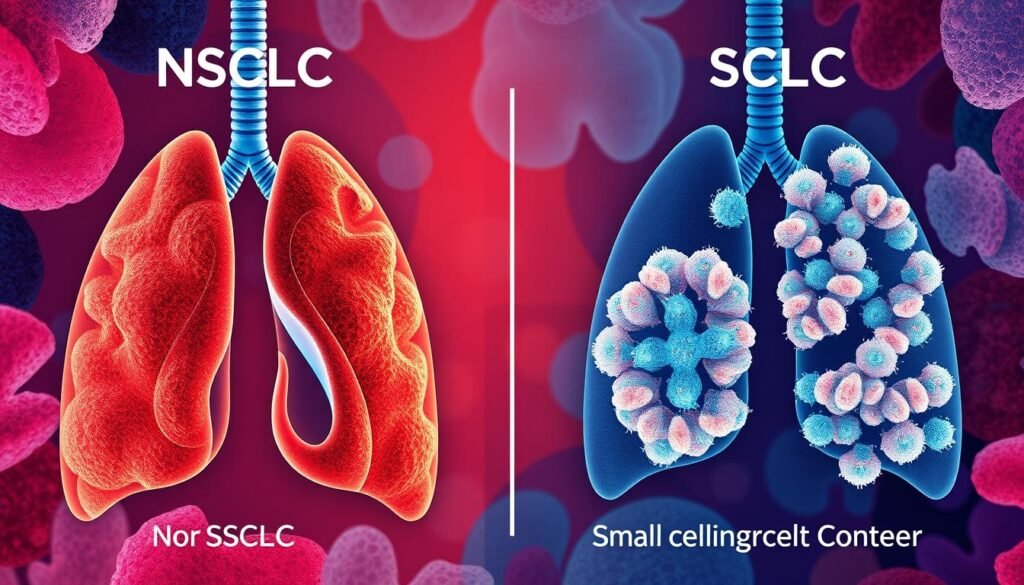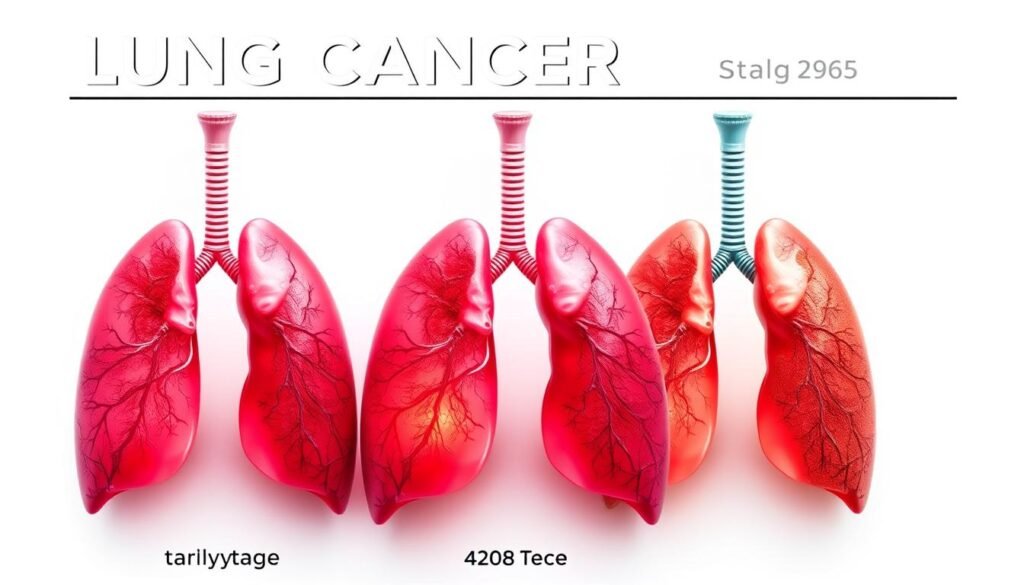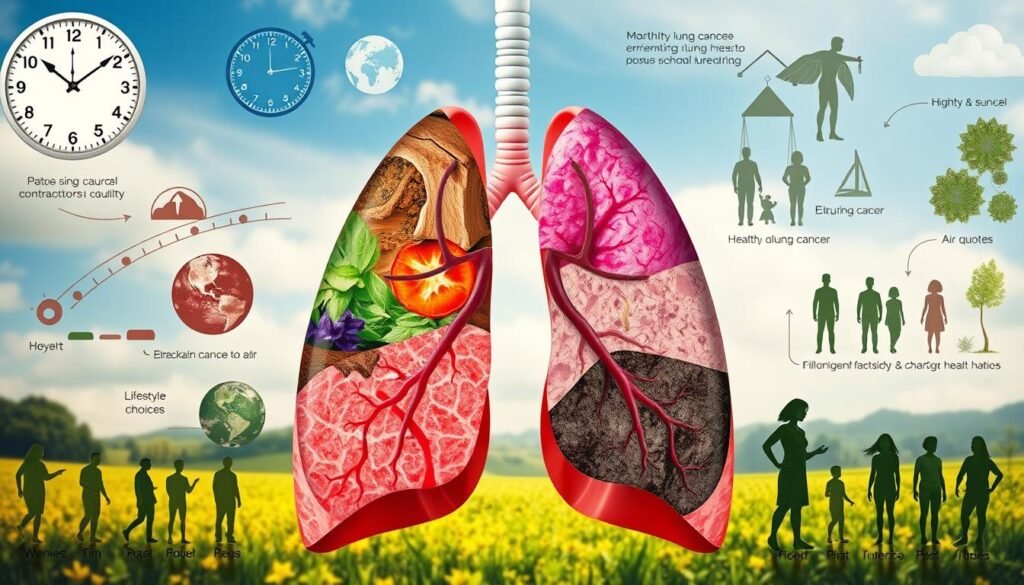Did you know that only 18.6% of people survive lung cancer over five years? This fact from the American Lung Association shows why knowing about lung cancer stages is so vital. Early detection can greatly affect your prognosis. This guide gives insights into lung cancer’s complexities, how survival rates change by stage, and what factors play a part in outcomes.
Survival rates for lung cancer show big differences across stages—70% to 90% for Stage 1 but only 3% to 9% for Stage 4. It’s clear that knowing life expectancy by stage is crucial for patients and families. It helps in making informed choices about treatment and understanding lung cancer’s prognosis better.
Key Takeaways
- The general 5-year lung cancer survival rate is 18.6%.
- Stage 1 lung cancer has a survival rate between 70% and 90%.
- Stage 4 lung cancer patients face a survival rate of 3% to 9%.
- Individual survival rates can vary based on health, age, and gender.
- Understanding lung cancer stages is critical for effective treatment planning.
Understanding Lung Cancer
Lung cancer is a serious disease. It starts when abnormal cells grow out of control in the lungs. This affects your breathing and can cause big health problems if not checked.
There are different types of lung cancer. Knowing these helps us understand the disease better.
Common symptoms include:
- Persistent coughing
- Shortness of breath
- Unexplained weight loss
- Chest pain
- Wheezing or hoarseness
Finding lung cancer early is key. If you see these signs, get help right away. This can make treatment work better. For more info, see this resource.
Getting diagnosed early can help a lot. It makes treatments more effective. In fact, lung cancer survival rates are getting better.
Most people have a type called non-small cell lung cancer. It makes up about 80–85% of cases. Small cell lung cancer is less common.
Being aware of lung cancer is very important. It can improve your health. Knowing the types and signs helps you make smart choices.
Types of Lung Cancer
Lung cancer includes mainly two types: Non-Small Cell Lung Cancer (NSCLC) and Small Cell Lung Cancer (SCLC). It’s important to know about these kinds. They each have their own features, ways to handle them, and chances of getting better.
Non-Small Cell Lung Cancer (NSCLC)
Most lung cancer patients, about 85%, have NSCLC. This type tends to grow slower than SCLC. There are different kinds within NSCLC like adenocarcinoma and squamous cell carcinoma. How long people live after they find out they have it depends a lot on how early it’s caught:
| NSCLC Stage | 5-Year Survival Rate |
|---|---|
| Localized | 60% |
| Regional | 33% |
| Distant | 6% |
| All Stages Combined | 23% |
Small Cell Lung Cancer (SCLC)
SCLC is not as common but is more aggressive. It grows quickly and is often found after it has spread. The chances of living five years or more with SCLC are lower than with NSCLC:
| SCLC Stage | 5-Year Survival Rate |
|---|---|
| Localized | 29% |
| Regional | 15% |
| Distant | 3% |
| All Stages Combined | 6% |

Life Expectancy by Lung Cancer Stage
Understanding life expectancy for lung cancer stages is key. It tells us about patient results and treatment paths. Early-stage lung cancer usually means a better chance of living longer. But, late-stage lung cancer is much harder to deal with.
Stage 1 Lung Cancer Statistics
Stage 1 non-small cell lung cancer shows good 5-year survival rates. They are between 70% and 92%. According to the TNM system, survival rates are:
- 1a1: 92%
- 1a2: 83%
- 1a3: 77%
- 1b: 68%
About 65% of people with localized NSCLC survive. Age plays a big role. Younger patients often do better than older ones.
Stage 2 Lung Cancer Statistics
Survival rates drop to around 40% at stage 2. Treatment still works, but choices become more important. Look at detailed survival stats and think about personal health.
Stage 3 Lung Cancer Statistics
Stage 3 lung cancer is tough, with survival rates at 15%. The cancer grows and might spread to lymph nodes. This requires complex treatments.
Stage 4 Lung Cancer Statistics
Stage 4 is the most severe, with only a 5% survival rate. It often means the cancer has spread widely. Early detection is critical to have more options.

Factors Affecting Lung Cancer Survival Rates
The journey through lung cancer is full of twists and turns. It’s affected by various factors that change survival rates. Health, age, and gender are big factors that influence how well someone may do.
Overall Health and Fitness
Good health is key in fighting lung cancer. Those in better health can handle treatments better, leading to improved survival. Studies show that people who’ve never smoked have a higher chance of survival than smokers.
For never-smokers, the survival rate after 30 months is 49%. Smokers, on the other hand, have a 32% survival rate. Being fit and free from lung diseases helps a lot too. A strong body means a better chance of handling the tough treatments.
Age and Gender Considerations
Age plays a big role in how well patients fare. People under 60 often have a better chance of surviving. But, lung cancer looks different in men and women. Women tend to do slightly better than men.
However, survival rates do not change much based on how old you are when diagnosed, your gender, or the type of lung cancer you have. This shows how complex lung cancer is. Every case is unique.

Lung Cancer Treatment Options
There are many treatments for lung cancer, depending on its type and stage. Knowing these options helps patients and their caregivers make informed decisions about their care.
Surgery
Surgery is key for treating early-stage lung cancer if it hasn’t spread. It aims to take out the tumor, doing so through different methods like segmentectomy or lobectomy. Sometimes, doctors use radiofrequency ablation (RFA) at the lung’s edges to kill cancer cells with heat.
Chemotherapy
Chemotherapy for lung cancer involves a mix of drugs given through the veins to stop cancer cells from growing. It’s especially for advanced stages or inoperable tumors. Chemotherapy works by attacking fast-growing cells, raising the chances of surviving when used with other treatments.
Radiation Therapy
Radiation therapy targets cancer cells with energy beams, playing a vital role in lung cancer treatment. It’s often paired with surgery or chemotherapy. Radiation can also help relieve symptoms from tumors that block the airways. Watching out for side effects like tiredness, trouble breathing, and swallowing issues is essential.
Immunotherapy
Immunotherapy boosts the body’s immune system to fight cancer, particularly effective against NSCLC. Side effects might be tiredness, skin rashes, or stomach problems.
| Treatment Type | Primary Uses | Common Side Effects |
|---|---|---|
| Surgery | Early-stage NSCLC, localized SCLC | Shortness of breath, chest pain, cough |
| Chemotherapy | Advanced lung cancer, postoperative therapy | Nausea, fatigue, hair loss |
| Radiation Therapy | Palliative care, localized treatment | Fatigue, pain, cough |
| Immunotherapy | Advanced NSCLC, targeted mutations | Fatigue, rashes, gastrointestinal issues |
Statistics on Long-Term Survival
Knowing about long-term survival for lung cancer is key for patients and their loved ones. The path to overcoming lung cancer greatly depends on the type and stage when found. Studies show that 5-year survival rates for lung cancer provide a reality check on what to expect. This shows why it’s vital to catch and treat it early.
5-Year Survival Rates
The 5-year survival rates for lung cancer vary between non-small cell lung cancer (NSCLC) and small cell lung cancer (SCLC). Below are some numbers:
| Type of Lung Cancer | Localized Stage | Regional Stage | Distant Stage |
|---|---|---|---|
| NSCLC | 65% | 37% | 9% |
| SCLC | 30% | 18% | 3% |
The overall 5-year survival rate is low, especially in advanced stages. For instance, NSCLC patients without treatment live around 7 months. Meanwhile, untreated SCLC patients have a life expectancy of 2 to 4 months.
Life Expectancy Without Treatment
This difference in outlook shows how critical timely treatment is. For example:
- NSCLC life expectancy: 11-13 months.
- SCLC life expectancy: 7-16 months.
Some lung cancer subtypes might have even shorter survival times, underlining the need for quick and strong treatment. To achieve long-term survival from lung cancer, medical care and a person’s health status play big roles. So, regular checks and catching the disease early are crucial.
The Prognosis After Diagnosis
Knowing about lung cancer prognosis means understanding why quick action is key. Finding lung cancer early greatly improves chances for a better outcome. Sadly, lung cancer found in stage 4 has a much tougher outlook than if caught early.
The Importance of Early Detection
Early detection of lung cancer can really change a patient’s future. Techniques like low-dose CT scans help spot it early in people at high risk. Catching lung cancer when it’s just starting means more ways to treat it and a better chance of living longer. Especially, catching non-small cell lung cancer early leads to much better survival rates than in late stages.
Studies show people in good health with lung cancer caught early tend to do better. Things like age, overall health, and how active you are matter. Also, if the tumor has certain features or if you haven’t lost a lot of weight before treatment, chances improve.
Below is a table showing how survival rates vary with the stages of lung cancer:
| Lung Cancer Stage | 1-Year Survival Rate | 5-Year Survival Rate |
|---|---|---|
| Stage 0 | 80%-90% | 70%-80% |
| Stage 1 | 75%-85% | 50%-60% |
| Stage 2 | 50%-67% | 30%-40% |
| Stage 3 | 30%-40% | 15%-25% |
| Stage 4 | 10%-20% | 5%-10% |
Talking with doctors about these survival numbers and your own situation is important. Understanding what the numbers mean can help make the best choices for your treatment road ahead.
Encouraging Stories of Lung Cancer Survivors
Stories of lung cancer survivors show deep resilience. Ed’s story is inspiring. He fought stage IV non-small cell lung cancer bravely. Doctors only gave him 9-12 months to live without treatment. But Ed decided to fight back. He joined immunotherapy trials and won his battle. By 2022, he showed no signs of the disease, highlighting the power of early treatment.
A lot of lung cancer patients find support groups helpful. This is especially true for those with ALK+ mutations. They share their victories and challenges. This gives others hope to keep fighting. Staying active after treatment helps survivors. It boosts their mood and strength greatly.
Many lung cancer cases are found early by accident during other screenings. This early discovery improves treatment success. Biomarker tests help find the best therapies for different lung cancer types. This approach has led to many success stories.
Lung cancer is tough, but many patients face it head-on. They treat it like a chronic illness they can manage. Their courage encourages others to fight too. To get inspired, check out these stories. They highlight the power of hope and community support.
Conclusion
Looking back at the journey through lung cancer, this article sheds light on the life expectancy that patients and their families deal with. Survival rates for stages III and IV range from 9.5% to 16.8%. It’s key to understand these numbers to have realistic hopes.
We must look at lung cancer forecasts for each person. We shouldn’t just depend on broad data. This approach helps in setting true-to-life hopes and plans.
Early detection can lead to better results, but many find out they have lung cancer too late. This often means the disease gets worse quickly. Talking to doctors who can offer treatments tailored to each person is critical.
Palliative care, as mentioned, is crucial for better quality of life. It supports patients in ways beyond just medical treatments.
Lung cancer’s journey is deeply personal and complex. Sharing stories can build connections and offer support to others. Knowledge and seeking aid are key to overcoming lung cancer’s challenges. This way, no one has to fight alone.